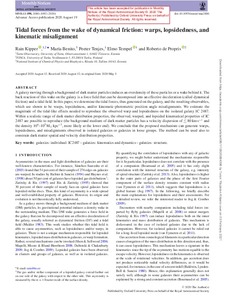Tidal forces from the wake of dynamical friction: warps, lopsidedness, and kinematic misalignment
Peeter Tenjes; María Benito; Rain Kipper; Roberto de Propris; Elmo Tempel
Tidal forces from the wake of dynamical friction: warps, lopsidedness, and kinematic misalignment
Peeter Tenjes
María Benito
Rain Kipper
Roberto de Propris
Elmo Tempel
OXFORD UNIV PRESS
Julkaisun pysyvä osoite on:
https://urn.fi/URN:NBN:fi-fe2021042825343
https://urn.fi/URN:NBN:fi-fe2021042825343
Tiivistelmä
A galaxy moving through a background of dark matter particles induces an overdensity of these particles or a wake behind it. The back reaction of this wake on the galaxy is a force field that can be decomposed into an effective deceleration (called dynamical friction) and a tidal field. In this paper, we determine the tidal forces, thus generated on the galaxy, and the resulting observables, which are shown to be warps, lopsidedness, and/or kinematic-photometric position angle misalignments. We estimate the magnitude of the tidal-like effects needed to reproduce the observed warp and lopsidedness on the isolated galaxy IC 2487. Within a realistic range of dark matter distribution properties, the observed, warped, and lopsided kinematical properties of IC 2487 are possible to reproduce (the background medium of dark matter particles has a velocity dispersion of less than or similar to 80 km s(-1) and the density 10(4)-10(5)M(circle dot) kpc(-3), more likely at the lower end). We conclude that the proposed mechanism can generate warps, lopsidedness, and misalignments observed in isolated galaxies or galaxies in loose groups. The method can be used also to constrain dark matter spatial and velocity distribution properties.
Kokoelmat
- Rinnakkaistallenteet [19218]
